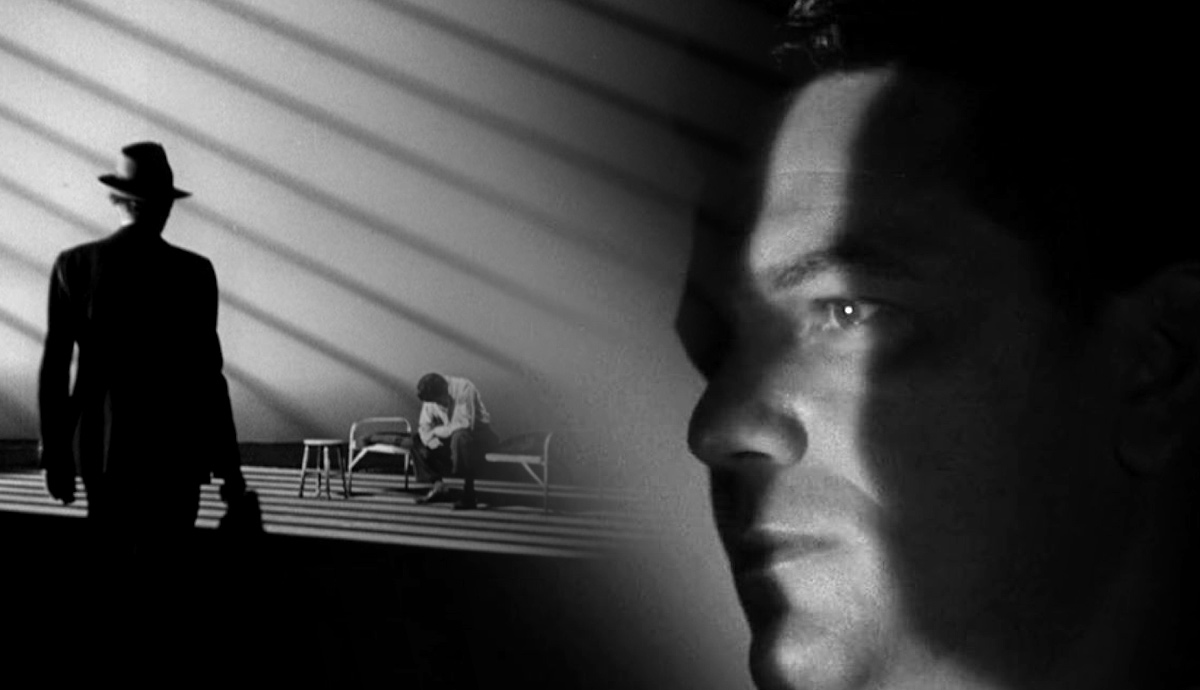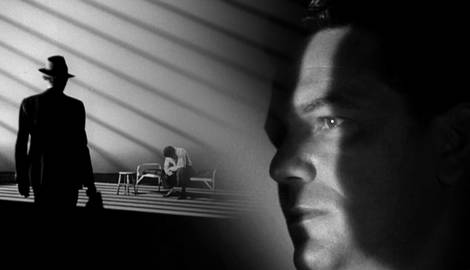
Trying to understand film noir and the stylish crime movies of the 40s can feel daunting. Film noir is a notoriously debated category and a label that encompasses some of the most interesting and boundary-pushing films of the 20th century. Here are 10 movies whose labyrinthine plots, darkened alleys, and bleak atmospheres are essential if you want to dive into the alluring shadows of film noir.
1. Stranger on the Third Floor by Film Noir’s Boris Ingster

Stranger on the Third Floor brought the first bold tendrils of noir to Hollywood. Featuring some of the strongest German expressionism influence in American cinema, the complex psychology and surreal direction of Stranger on the Third Floor made for an audacious departure from crime films of the 1930s. We follow a journalist named Mike Ward (John McGuire) who witnesses a grizzly murder. Earning himself a major scoop with the tragedy, he serves as the main witness to the prosecution, but quickly begins to question his judgment and even his own sanity as a stranger (Peter Lorre) begins to prowl around the scene.
The pointed critiques of the judicial system, and exploration of morality, insanity, and guilt, are expertly expressed in Nicholas Musuraca’s cinematography, Van Nest Polglase’s design, and Boris Ingster’s direction. The stark lighting, oppressive sets, nightmarish blur between reality and delirium, and Peter Lorre’s stellar performance are the perfect bridge between expressionism and film noir.
2. The Maltese Falcon by John Huston

The Maltese Falcon was the third movie adaptation of Dashiell Hammet’s 1930 novel, a pulp fiction hit that revolutionized the detective genre. John Huston’s picture, unlike its predecessors, captured the detail-oriented, shrewd, hard-boiled approach to crime and mystery and kicked off Hollywood film noir. When the plea of a distressed woman leads to the death of his partner, private investigator Sam Spade (Humphrey Bogart) finds himself entangled with the betrayals and mysteries surrounding three unscrupulous adventurers seeking a legendary artifact.
Hammett’s writing, John Huston’s vision, and the fantastic cast set the quintessential noir characters: Humphrey Bogart as the tough, morally gray anti-hero, Mary Astor as the femme fatale with hints of tragedy, and Pete Lorre as an amoral chameleon. Arthur Edeson’s cinematography has a simple flair. The shadows are more fuzzy than expressionistic, but The Maltese Falcon perfectly reflects the bleak, street-wise tone of the mystery and sets the stage on which film noir would flourish.
3. Laura by Otto Preminger

Based on Vera Caspary’s 1943 novel, Laura is a high-society drama with a noir spin. Otto Preminger’s Laura, alongside Gilda (1946) with Rita Hayworth, established the most iconic noir women. Both these movies center their layered female characters, even as they objectify them.
In Laura Detective Mark McPherson (Dana Andrews) investigates the violent murder of Laura Hunt (Gene Tierney), a wealthy, successful, and beautiful advertiser. Interviewing the shady characters of Laura’s cohort and lingering in front of a painting of Laura, Detective McPherson slowly becomes obsessed with his case’s victim, as does the audience. As the not-quite femme fatale Laura unwittingly spins webs of desire, fascination, and perversity, Laura features some of the best twists and turns of any murder mystery in cinema. The cinematography by Joseph LaShelle and Preminger’s directing makes it the most darkly charming offering among film noir.
4. Double Indemnity by Billy Wilder

Double Indemnity is regarded not only as an essential film noir but one of the best movies of all time. It did not start film noir, premiering in 1944, but it shaped the genre forever. Double Indemnity opens careening into the rain-soaked streets and gleaming neon of a dark city. We go on to follow Walter Neff (Fred MacMurray), an insurance salesman, limping into a Dictaphone to record a confession: he committed a murder. “I did it for money, and I did it for a woman; I didn’t get the money, and I didn’t get the woman,” Neff says, encapsulating in the first few minutes the ennui that runs through all of film noir.
Based on a novella by James M. Cain, with an adapted screenplay by Raymond Chandler, Double Indemnity brought to Hollywood a thriller of unprecedented pessimism, developing a ruthless story of common citizens corrupted by greed and desire. Billy Wilder directs Barbara Stanwyck as the quintessential femme fatale Phyllis Dietrichson and a scene-stealing Edward G. Robinson as insurance claims investigator Barton Keyes. John Seitz’s photography of lonely streets, expressionistic shadows, and ominous reflections sets the standard for the noir world. All of this is complemented by Miklós Rózsa’s iconic score.
5. Force of Evil by Abraham Polonsky

In Abraham Polonsky’s Force of Evil, John Garfield is Joe Morse, a bigshot lawyer working for vicious mob boss Ben Tucker (Roy Roberts). As Tucker plans a hostile takeover of New York City’s rackets, Joe scrambles to get big and get his brother (Thomas Gomez) out of the line of fire. The screenplay was adapted by Polonsky from journalist Ira Wolfert’s 1943 novel Tucker’s People, a fictionalized account of his investigation into the corruption of NYC’s rackets. Force of Evil was both Abraham Polonsky’s directorial debut and the last movie he’d make in twenty years. Soon after, he was targeted by the House Un-American Activities Committee and blacklisted.
Force of Evil was quite the work to leave on. Polonsky’s poetic dialog and George Barnes’s photography captured New York at its most Hopperesque. Force of Evil is a voracious thriller and sharp critique of American society in one, a poignant narrative showing that the noir underbelly is not restricted to the dark corners of the city, but that it can also be set in the gleaming buildings of Wall Street.
6. White Heat by Raoul Walsh

Appallingly cruel for its time, even in the context of film noir, White Heat follows ruthless gangster and momma’s boy Cody Jarrett (James Cagney). Jarrett is a criminal suffering from white heat migraines that ramp up his already high homicidal tendencies and he seeks to evade the law and fulfill his promise to his mother (Margaret Wycherly).
Released as the red scare hysteria began to take hold of Hollywood, White Heat opposes itself to movies like Force of Evil that depict the roots of crime in social inequality and corruption. It did so by exploring the psychiatric and genetic roots of crime. Cody Jarett is an early and unforgettable example of a criminal with mommy issues, an archetype that would be revisited many times in cinema. Raoul Walsh directs James Cagney, known for playing gangsters in the 1930s, into revitalizing the archetype. Even at an age where such movies have become almost banal, White Heat is a tightly constructed thriller, a noir taken up a notch, with a compelling, volatile anti-hero going so spectacularly off the rails the audience can do nothing but watch him crash.
7. The Killers by Robert Siodmak

Robert Siodmak’s The Killers is film noir’s bread and butter. All the noir staples are here: tough investigators, doomed average citizens turned criminals, destructive femme fatales, sleazy clubs, and fighting rings tied off with beautiful expressionistic lighting. The Killers is Burt Lancaster’s screen debut where he plays Ole Swede Anderson, a boxer turned thief by a bad hand of fate and the fatally alluring Kitty Collins (Ava Gardner). The movie opens with Swede’s shooting, which he accepts with hopeless resignation. The aftermath investigation handled by life insurance investigator Jim Reardon (Edmond O’Brien) pieces together the dark twists and turns of the Swede’s past and his premeditated murder. Adapted from Ernest Hemingway’s 1927 novella, The Killers features cinematography by Woody Bedell and a score by the iconic Miklós Rózsa. Beautifully composed shots and perfectly planned shadows are the reason why the film became famous as the Citizen Kane of crime movies.
8. Sunset Boulevard by Billy Wilder

After kicking the genre into high gear with Double Indemnity and penning the perversely sharp Ace in the Hole (1951), Billy Wilder still had one more masterpiece in store for film noir. Sunset Boulevard is another collaboration with cinematographer John Seitz, illuminating the shadows of the film industry itself. The movie starts off with Joe Gillis (William Holden) floating face-down on a pool with a bullet in his back. Gillis, a down-on-his-luck screenwriter narrates how, in trying to escape his debts, he became entangled in the suffocating world and comeback delusions of the aging silent film star Norma Desmond (Gloria Swanson).
Exploring the transition from silent films to talkies, Sunset Boulevard exposes and satirizes the Hollywood industry, how it uses its talent ruthlessly and discards them, all with the edge and gloom of noir. This is made more poignant by the cast: Gloria Swanson and Erich von Stronheim, a silent film star and director, play Norma Desmond and Max von Mayerling, silent era relics living in delusion. Director Cecil B. DeMille and columnist Hedda Hopper play themselves, while many silent era stars like H.B Warner, Anna Nilsson, and Buster Keaton—who lost their careers as Hollywood transitioned to sound—have cameos.
9. Sweet Smell of Success by Alexander Mackendrick

Sweet Smell of Success is an odd film noir. It features no femme fatales, no investigators, tortured or otherwise, and no murder. Yet, few films capture the bleak outlook and cynical nature of film noir in such a vivid manner. Tony Curtis and Burt Lancaster are contenders for the most toxic of all noir duos in Sweet Smell of Success, playing unscrupulous PR agent Sidney Falco (Curtis) and fearsome Broadway columnist J.J Hunsecker (Lancaster). When Hunsecker forces Falco to ruin his sister’s relationship, we descend through all the rotten, seedy layers of New York’s show business journalism.
In a film about writers and journalists, the snarky dialogue takes a central role. Cinematographer James Wong Howe and director Alexander Mackendrick capture New York at its most frenetic and imbue the film with a breathlessly intense atmosphere. The diegetic jazz performances by the Chico Hamilton Quintet add a new dimension to the soundtrack. The artistic skill at play and the many animosities running high backstage add to the hostile energy that pervades every scene of Sweet Smell of Success.
10. Film Noir’s Touch of Evil by Orson Welles

Orson Welles’ masterwork Touch of Evil is noir at its most baroque. It is often regarded as the last classic noir film. Detective Miguel Vargas (Charlton Heston) pauses his honeymoon to look into an incident at a small town on the United States-Mexico border. He is forced to wade through a cruel web of vengeance and moral decay. Loosely based on the 1956 novel Badge of Evil, Touch of Evil is a cruel crime potboiler elevated to a cinematic tour de force. Orson Welles’ dauntless creative directing and the superb camerawork by Russell Metty make ample use of off-kilter framing, deep angles, and exaggerated lighting inherited from expressionism, pushing film noir visuals to their very limit. From the opening long shot to its somber end, Touch of Evil brings the audience into a tale of crime, sex, drugs, moral decay, racial tensions, and corrupted ideals.










